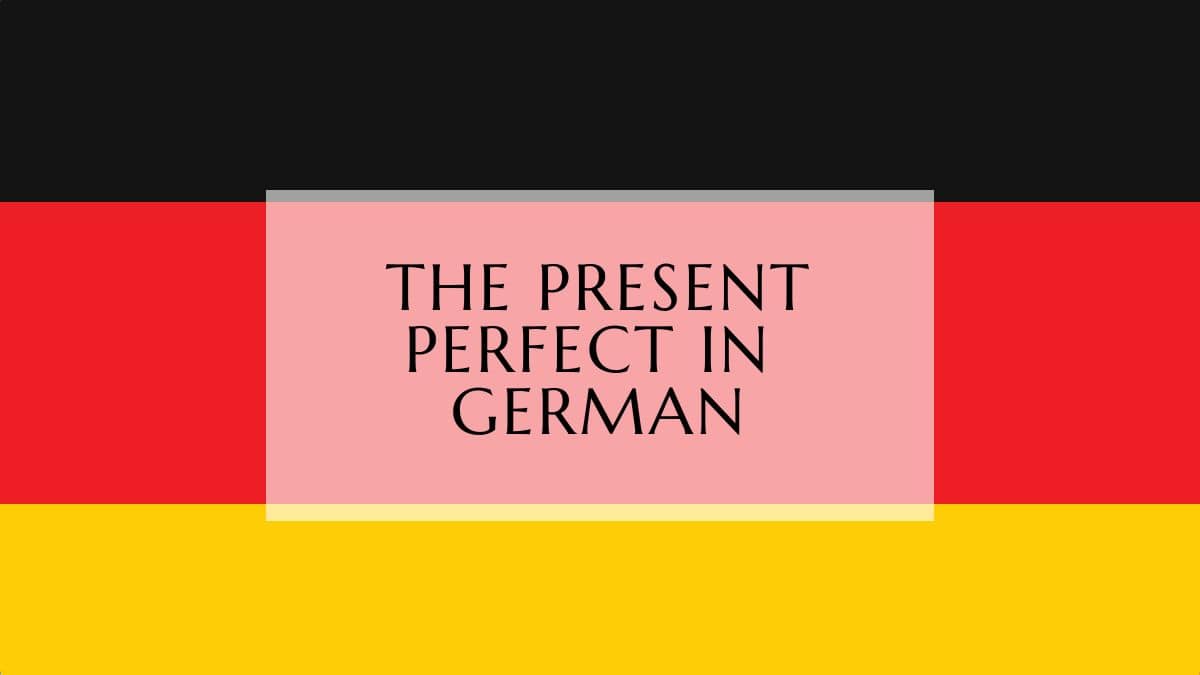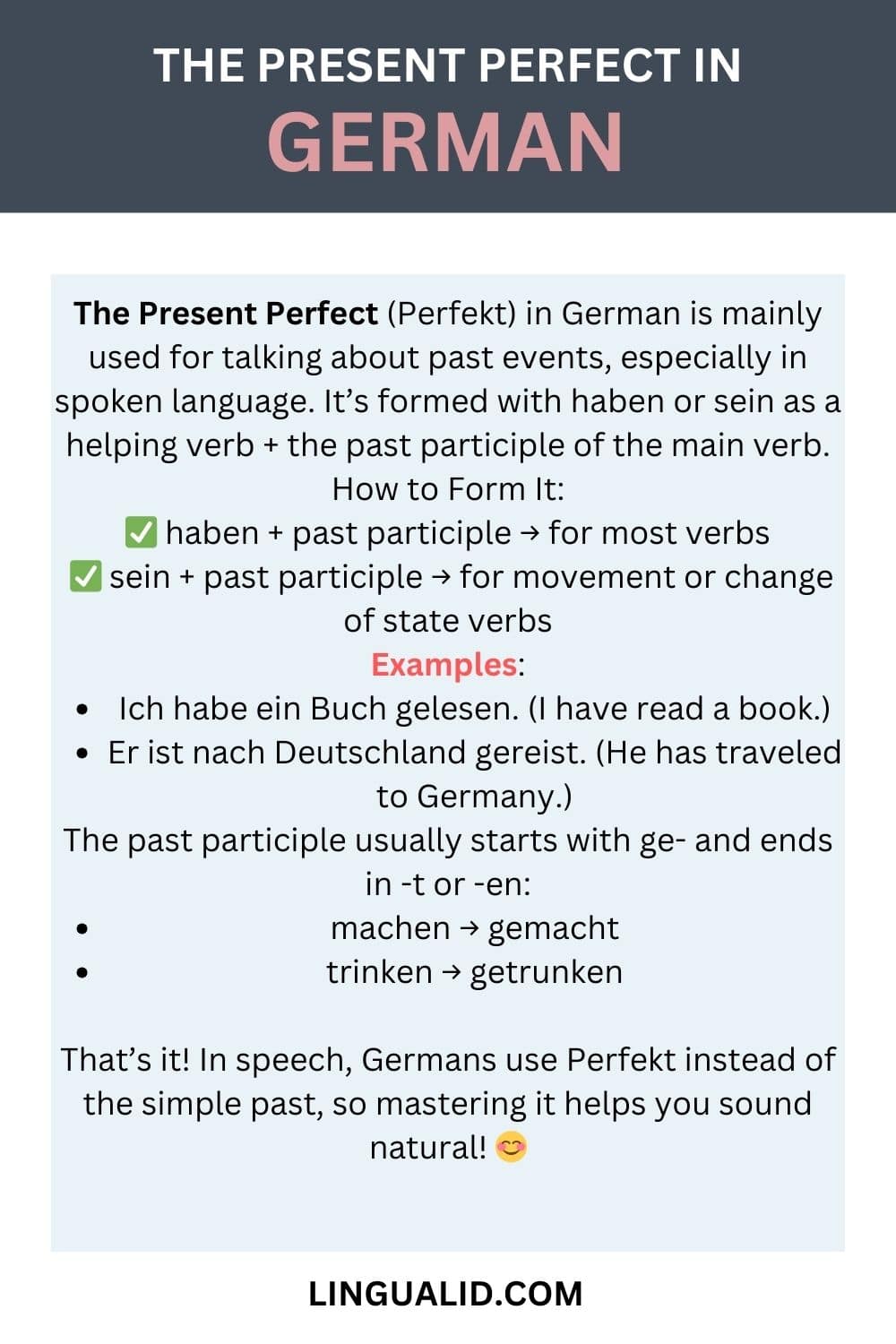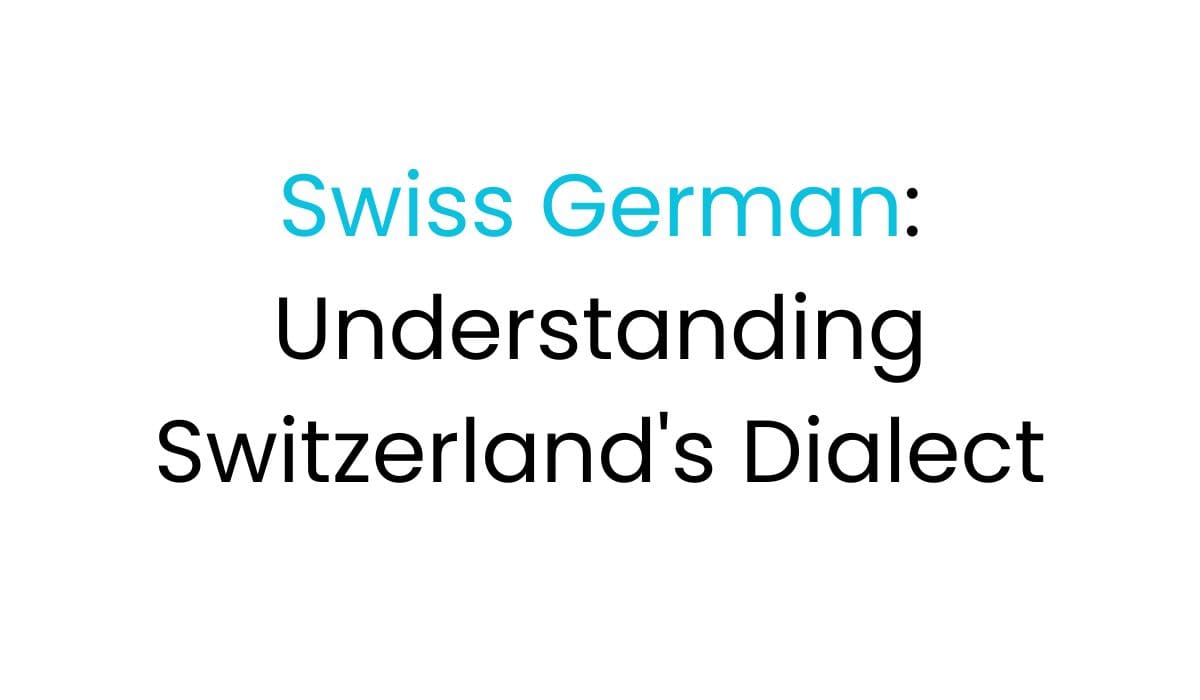Learning the Present Perfect in German (Perfekt im Deutschen) might seem hard at first. But it’s a key skill for anyone learning the language. This tense is very common in spoken German, making it vital for daily talks.
The Perfekt tense is key for talking in German, it lets learners tell stories and share personal experiences. The Present Perfect in German uses an auxiliary verb and a past participle to describe past actions.

- Understanding Present Perfect in German (Perfekt)
- Essential Components: Haben vs. Sein as Auxiliary Verbs
- Past Participle Formation for Regular Verbs
- Mastering Strong Verbs in Present Perfect
- Special Cases: Mixed and Irregular Verbs
- Present Perfect in German: Word Order and Sentence Structure
- Separable and Inseparable Verbs in Present Perfect
- Common Mistakes to Avoid with German Present Perfect
- Practice Strategies and Exercises for Present Perfect Mastery
- FAQ
- What is the German present perfect tense (Perfekt)?
- How do I choose between 'haben' and 'sein' as an auxiliary verb?
- How do I form the past participle for regular verbs?
- What are strong verbs in the present perfect?
- Where does the past participle go in a German sentence?
- Do all verbs use 'ge-' in their past participle?
- What's the difference between mixed verbs and strong verbs?
- How often is the present perfect used in spoken German?
- What are some common mistakes learners make with the present perfect?
- How can I practice and improve my use of the present perfect?
Understanding Present Perfect in German (Perfekt)
Learning the Zeitform Perfekt in German is an exciting journey. It has a unique structure that’s different from English present perfect. This form is key for talking about past actions in German.
- An auxiliary verb (haben or sein)
- The past participle of the main verb
Basic Structure and Formation
The German present perfect has a specific pattern. The auxiliary verb comes second, and the past participle is at the end. It might seem hard at first, but gets easier with practice.
| Verb Type | Past Participle Ending | Example |
|---|---|---|
| Regular Verbs | -t | gemacht (done) |
| Irregular Verbs | -en | gesungen (sung) |
Key Differences from English Present Perfect
German speakers often use the present perfect in daily talks. Unlike English, they prefer the Perfekt tense for past actions.
When to Use Present Perfect in German
The Perfekt tense is mainly for:
- Describing completed past actions
- Talking about past events in casual settings
- Sharing recent experiences
To master this tense, you need to know when to use haben or sein. This depends on the verb’s type.
Essential Components: Haben vs. Sein as Auxiliary Verbs
Learning the perfect tense in German means knowing the difference between haben and sein. These verbs are key to making the perfect participle. They help form the perfect tense in German grammar.
Choosing the right auxiliary verb is simple: most verbs use haben. Verbs with direct objects always use haben. Even intransitive verbs without direct objects usually do too.
- Verbs indicating movement or change of state use sein
- Most transitive verbs use haben
- Intransitive verbs showing location change require sein
Now, let’s look at the main differences between haben and sein:
| Verb Type | Auxiliary Verb | Example |
|---|---|---|
| Transitive Verbs | Haben | Ich habe einen Kuchen gebacken (I have baked a cake) |
| Movement Verbs | Sein | Ich bin nach Berlin gefahren (I have traveled to Berlin) |
| State Change Verbs | Sein | Er ist gestorben (He has died) |
About 70-80% of verbs use haben, and 20-30% use sein. It takes practice to get used to these patterns. But, the more you practice, the easier it becomes.
Tip for German learners: If you’re unsure, choose haben for most perfect tense verb forms.
Past Participle Formation for Regular Verbs
Learning the Partizip Perfekt for regular German verbs is key to mastering the language. The rules for making past participles are simple and easy to follow. This makes verb formation predictable and straightforward.
Regular verbs in German, also known as weak verbs, have a consistent pattern for creating past participles. The process involves two main steps that are easy to remember.
Adding the ge- Prefix
The first step is adding the ge- prefix to the verb stem. This prefix shows the verb is in its past participle form. For most regular verbs, this prefix goes at the start of the word.
- spielen → gespielt
- lernen → gelernt
- fragen → gefragt
Rules for -t Ending
After adding the ge- prefix, regular verbs usually end with -t. If the verb stem ends in -t or -d, an extra -e is added before the -t. This makes pronunciation smoother.
Common Regular Verb Examples
| Infinitive | Past Participle | English Translation |
|---|---|---|
| spielen | gespielt | to play |
| arbeiten | gearbeitet | to work |
| fragen | gefragt | to ask |
By understanding these simple rules, you’ll quickly become confident in forming past participles for regular German verbs.
Mastering Strong Verbs in Present Perfect
Strong verbs are key in Deutsch Grammatik and can be tough for learners. Unlike regular verbs, they have special traits that make them unique in German.
In German grammar, strong verbs are irregular. They change their stem vowel when forming the past participle. These verbs keep the -en ending and need extra care when conjugating.
- Strong verbs modify their stem vowel
- They maintain the -en ending in past participle
- Vowel changes are unpredictable
Now, let’s look at some common strong verb patterns in the Perfekt tense:
| Infinitive | Past Participle | English Translation |
|---|---|---|
| fahren | gefahren | to drive |
| essen | gegessen | to eat |
| nehmen | genommen | to take |
Learning these verb forms might seem hard, but practice helps. With time, you’ll get better at using them. Native speakers use these verbs easily, and you can too.
Pro tip: Make flashcards or use apps to practice strong verb forms in the Perfekt tense. The more you practice, the better you’ll get.
Special Cases: Mixed and Irregular Verbs
Learning Bildung des Perfekts gets tricky with mixed and irregular verbs. These verbs need extra focus in German, offering a challenge and a chance to get better.
Identifying Mixed Verb Characteristics
Mixed verbs are special in German grammar. They mix regular and strong verb traits. They follow their own rules for the Perfekt, making them different from usual verb forms.
- Combine weak verb endings with stem vowel changes
- Modify the infinitive ending from -en to -t
- Exhibit irregular stem transformations
Common Irregular Verb Patterns
Some mixed verbs show up a lot in German. Here are a few examples:
- bringen (to bring) – hat gebracht
- denken (to think) – hat gedacht
- rennen (to run) – ist gerannt
- wissen (to know) – hat gewusst
Memory Techniques for Challenging Forms
Getting good at these irregular verbs takes smart learning. Use mnemonics, practice often, and learn the patterns. This helps remember these tricky verb forms better.
By understanding mixed verbs and using the right learning methods, you can handle these grammar details with confidence.
Present Perfect in German: Word Order and Sentence Structure
Learning the word order for German Zeitform Perfekt is key. It involves understanding some important rules. The perfect tense in German has a specific pattern that might seem hard at first. But, it gets easier with practice.
In standard German, the auxiliary verb (haben or sein) always comes second. This rule works for about 95% of sentences in the Vergangenheitsform. The past participle usually goes at the end of the sentence. This creates a unique sentence structure.
- Auxiliary verb always appears in second position
- Past participle moves to the end of the sentence
- Follows the TeKaMoLo rule (Temporal, Causal, Modal, Local)
Let’s look at a typical sentence structure with an example:
- Ich habe (auxiliary verb – 2nd position) gestern (time element) einen Kuchen gebacken (past participle – end of sentence).
- Translation: I baked a cake yesterday.
Subordinate clauses add a twist. With a subordinating conjunction like weil (because), the verb goes to the end of the clause. This shows the complexity of German Zeitform Perfekt sentence building.
With practice, these word order rules will become second nature. Soon, making perfect tense sentences will feel natural. This will help with smoother German communication.
Separable and Inseparable Verbs in Present Perfect
Learning about Partizip Perfekt in Deutsch Grammatik can be tough. This is especially true for separable and inseparable verbs. They have their own rules that can confuse even those who know some German.
German verbs with prefixes are either separable or inseparable. Knowing how they work in the present perfect tense is key to getting better at German.
Rules for Separable Prefixes
Separable verbs have their own way of forming the Partizip Perfekt:
- The prefix ge- goes between the prefix and the verb stem
- For example, einkaufen (to shop) becomes eingeekauft
- Common prefixes include: ab-, an-, auf-, aus-, ein-
Treatment of Inseparable Prefixes
Inseparable verbs in Deutsch Grammatik act differently in the present perfect tense:
- No ge- prefix is added to the past participle
- Verbs starting with be-, ver-, miss- usually don’t get this prefix
- For instance, verkaufen becomes verkauft
Getting good at these verb types takes practice and paying close attention to prefixes. With time, you’ll get better at spotting separable and inseparable verbs in your German studies.
Common Mistakes to Avoid with German Present Perfect

Learning the German Present Perfect can be tough. It needs careful attention and knowing common mistakes. These mistakes can affect even advanced learners.
When learning a new language, you’ll face errors. In German, some common mistakes can mess up your messages:
- Selecting the incorrect auxiliary verb (haben or sein)
- Incorrectly forming past participles
- Misplacing the past participle in a sentence
- Overlooking verb-specific conjugation rules
Many learners struggle with choosing the right auxiliary verb. Most verbs use haben, but some need sein. Verbs about movement or change use sein, making up about 10% of perfect tense uses.
Getting the pronunciation and placement right is key. The past participle must be at the sentence’s end.
Negation is another tricky area. The word nicht goes right before the past participle. Beginners make many mistakes with negation in their sentences.
Here are some tips to avoid mistakes:
- Practice identifying verbs that use sein
- Learn regular and irregular verb formations
- Pay close attention to sentence structure
- Use language learning resources consistently
Regular practice can boost your perfect tense skills by up to 50% in three months. Remember, mistakes are part of learning. Each error is a chance to get better at German.
Practice Strategies and Exercises for Present Perfect Mastery
Mastering Perfekt im Deutschen needs regular practice and smart learning methods. Flashcards are great for learning haben/sein + Partizip Perfekt. Make sets for regular and irregular verbs. Spend 10-15 minutes each day to improve your German verb skills.
Digital tools can really help your learning. Apps like Duolingo and Babbel have fun exercises for the present perfect tense. They give you feedback and make learning grammar fun.
Immerse yourself in the language. Talk to native speakers, watch German movies, or listen to podcasts. This way, you’ll get used to the Perfekt im Deutschen naturally.
Join German conversation groups or find a language partner. Record yourself and check your verb use. Regular practice makes grammar easy to use.
FAQ
What is the German present perfect tense (Perfekt)?
How do I choose between ‘haben’ and ‘sein’ as an auxiliary verb?
How do I form the past participle for regular verbs?
What are strong verbs in the present perfect?
Where does the past participle go in a German sentence?
Do all verbs use ‘ge-‘ in their past participle?
What’s the difference between mixed verbs and strong verbs?
How often is the present perfect used in spoken German?
What are some common mistakes learners make with the present perfect?
How can I practice and improve my use of the present perfect?
Oualid Cheddadi is the founder of Lingualid, a platform that inspires independent language learners worldwide, regardless of the language they are learning. The name “Lingualid” is derived from the Portuguese word for “language,” “língua,” and the last three letters of Oualid’s name, “Lid.”



